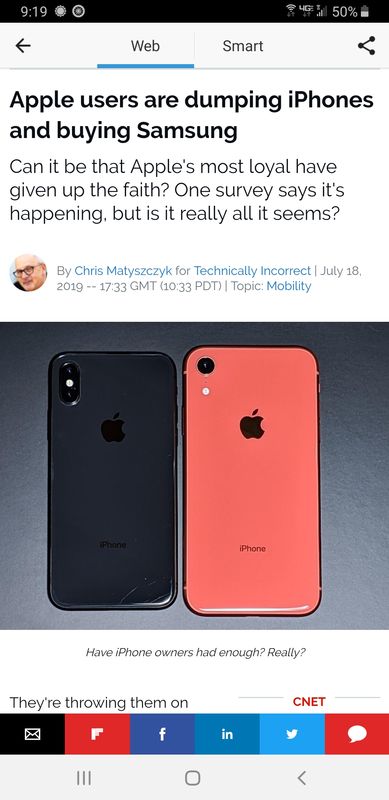iPhone Camera vs DSLR quality?
Jul 19, 2019 16:28:26 #
Hamltnblue
Loc: Springfield PA
GailConnorsPhotography wrote:
Hi, new but been with you forever, & am sure t... (show quote)
Hi Gail
Welcome to the land of people with nothing better to do than harass others asking questions. I see you've met the crew and have gone through the hazing.
I would say that using the word quality is probably not the correct one.
IMO it would be the difference in application.
The modern day phone camera and associated software has come a long way and can produce some impressive results, as long as the photo taken falls within the optimum parameters of the equipment.
The sensors in phones have improved significantly. They have also improved significantly in DSLR's
We can assume that the sensor quality of the cell phone is on par with most consumer DSLR's. They're just smaller. As you know the size of the sensor will determine the amount of photocells available and the sensitivity of them. The larger the sensor, the more light available. The result is that the DSLR will be able to use the extra light available in darker situations and also allow for faster, action stopping shutter speeds when brighter.
With the format difference comes a variety of lens options.
Yes, there are add on lenses for cell phones that work quite well and provide additional options. There are even more options available to DSLR's, because they don't have to fit in a pocket.
Most will probably agree that the lens is the most significant piece of any setup.
You can capture the highest details of any subject from a fly eye to some planets with the right lens. Those scenario's simply are not available nor were they intended on the phone.
During a recent sunset in a tourist area, I had my tripod with Mirrorless/Dslr camera. A few others had their dedicated cameras, and dozens of others were taking pics with their cell phones. I think I can confidently say that the area below the sunset including the horizon was dark for most. Using the DSLR allows for bracketed photos with spot metering. The resulting HDR photo showing all details would not be matched with the cell. Long exposure night shots repeat the story.
These are examples of application.
Do modern cell phones take great pics? The answer is yes during the right scenarios. Sometimes even competing with DSLR results under print with a good user.
Many other times, not even close.
Good Luck with your class. I hope it results in making more people interested in photography.
Jul 19, 2019 16:33:36 #
Jul 19, 2019 16:38:20 #
GailConnorsPhotography wrote:
Put beautifuly!!!!
Hi. If someone hasn't mentioned it yet, click on "Quote Reply" or we will not know which post you're responding to. Great thread.
Jul 19, 2019 16:41:35 #
Race Raccoon wrote:
Gail, I am shocked & very disappointed by the haughty & disrespectful manner in which you and your perfectly reasonable questions have been greeted here.
Your service to our country, your credentials, and the fact you are a lady entitle you to better than you have received here.
This 69 yo white male with 34 years of service to the same country you have served is ashamed at the way you've been treated.
Your service to our country, your credentials, and the fact you are a lady entitle you to better than you have received here.
This 69 yo white male with 34 years of service to the same country you have served is ashamed at the way you've been treated.
Yes, the thread got off to a negative start, but there have been some outstanding comments I hope will be of use.
Jul 19, 2019 16:51:18 #
fehutch
Loc: gulfport, ms
Sorry that some are so “ruffled”.. Anyway, my wife does the scrapbook for a women club and they all submit photos (cell phone pix). Beyond a 4x6, 98% are terrible. Besides shaky, the quality just isn’t there. There ain’t enuff shop in photoshop to fix blurry images and quickie group shots. I keep a canon S100 in each car and manage to smuggle a few pix from it into the pile from every important event she/we attend. With no photo credits, nobody is wiser. And nobody gets hurt feelings.
Jul 19, 2019 16:52:47 #
TriX wrote:
See attached graph (source: http://www.photonstophotos.net/Charts/PDR.htm )
Iphone 7: DR=7.5, Low light ISO=45
Canon 5D4: DR=10.8, Low light ISO=5011
Iphone 7: DR=7.5, Low light ISO=45
Canon 5D4: DR=10.8, Low light ISO=5011
This is great! Thx
Jul 19, 2019 17:10:35 #
GailConnorsPhotography
Loc: Holbrook, MA
E.L.. Shapiro wrote:
Hi, Gail! Welcome to the forum. br br You did no... (show quote)
Jul 19, 2019 17:36:12 #
"Non Illegitimi Carborundum"
(Don't let the bastards grind you down)
(Don't let the bastards grind you down)
Jul 19, 2019 17:47:09 #
Teach by example. Thats where the truth lives. Actual real world examples. Examples of all kinds of lighting, color and dynamic range. Make prints, enlarge, display on various displays. Push some processing lattitudes. A picture is worth a thousand words, easily. The students themselves will see, as you do. What ya see is what ya get. How ya get what ya see follows. Otherwise, what are you really "teaching"?
Jul 19, 2019 17:55:47 #
fehutch wrote:
Sorry that some are so “ruffled”.. Anyway, my wife does the scrapbook for a women club and they all submit photos (cell phone pix). Beyond a 4x6, 98% are terrible. Besides shaky, the quality just isn’t there. There ain’t enuff shop in photoshop to fix blurry images and quickie group shots. I keep a canon S100 in each car and manage to smuggle a few pix from it into the pile from every important event she/we attend. With no photo credits, nobody is wiser. And nobody gets hurt feelings.
Do you know WHY those images won’t go up to larger sizes?
It’s because email programs, social media sites, and text messaging software all tend to downsample the phone images to smaller pixel dimensions, and then compress them heavily, by default.
If you know what you’re doing, you can override default settings and send original images.
Jul 19, 2019 18:08:32 #
fehutch
Loc: gulfport, ms
I do, but the ladies sending probably don’t. Am at the mercy of the sources. My only point was- regarding the original question - was: essentially camera beats cell phone every time.
Jul 19, 2019 18:43:17 #
I shoot with both. But use my DSLR for most photography. Way more options, control,lenses. Love my phone for when there's a picture I want and that's all I have.
Jul 19, 2019 18:51:36 #
In any smartphone the dimensions of the phone real estate places limits on lens and sensor dimensions and their spacing. How thick is the phone. After deducting the thickness of tbe screen and circuit board, how far apart can the lens and sensor can be. For the lens, how big is the hole for it - that places a lower limit on the radius of curvature and defines one end of the focal length achievable. All of this will define an angular cone of some base radius which defines the sensor size. I have looked around for iPhone 8+ design specs without success so can’t get specific.
Jul 19, 2019 19:04:52 #
Burk, what do you suggest to get the native smartphone image out into a computer. My iPhone 8+ does not have a SSD chip. Also, Photoshop alternatives.
burkphoto wrote:
Do you know WHY those images won’t go up to larger sizes?
It’s because email programs, social media sites, and text messaging software all tend to downsample the phone images to smaller pixel dimensions, and then compress them heavily, by default.
If you know what you’re doing, you can override default settings and send original images.
It’s because email programs, social media sites, and text messaging software all tend to downsample the phone images to smaller pixel dimensions, and then compress them heavily, by default.
If you know what you’re doing, you can override default settings and send original images.
Jul 19, 2019 19:26:54 #
I don't have an iPhone but do have a Samsung Galaxy S5 (rather old by today's standards). I never printed any of the photos on my phone because I just assumed anything above 4 x 6 or 5 x 7 would not look good. Recently, I had a need to print an 8 x 12 picture I had on my phone. Again, I assumed it would not look very good. I was surprised. It looked as about as good as 8 x 12s from my Canon 60D (also old by today's standards). I assume that the cameras on today's iPhone or Galaxy are lots better than mine and should produce better pictures. I liked the suggestion to take the best picture you can with your phone and make several prints of various sizes to see how big the phone camera can take you and still look good. If I were teaching a course, I would have my students use their phones to take a variety of pictures under different conditions, make prints of various sizes and see what, if any, limitations there are on phone photography. Do the same with a point and shoot and a DSLR camera and compare the results.
If you want to reply, then register here. Registration is free and your account is created instantly, so you can post right away.



